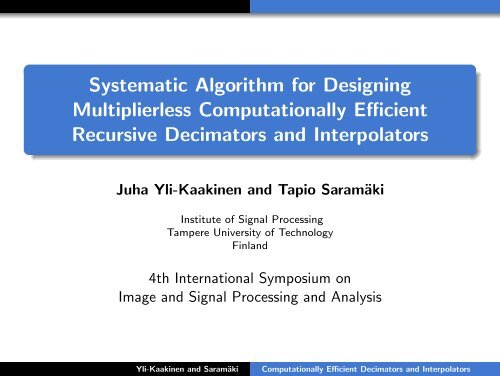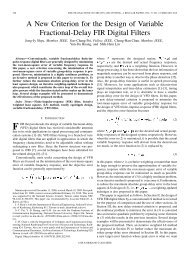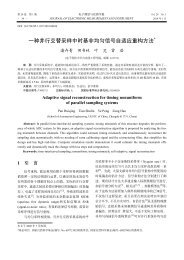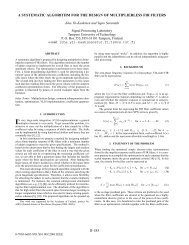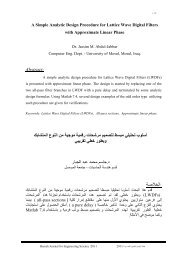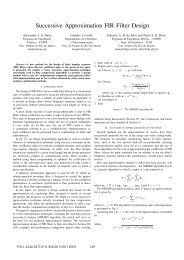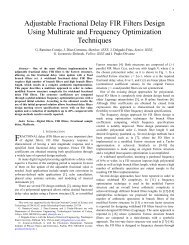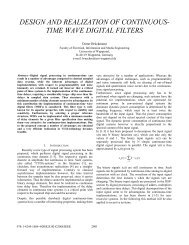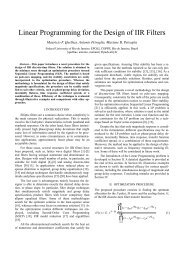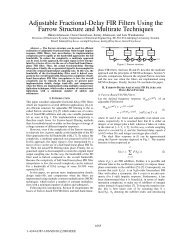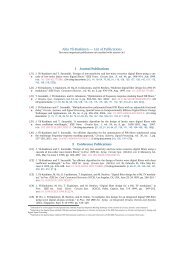Presentation - Juha Yli-Kaakinen
Presentation - Juha Yli-Kaakinen
Presentation - Juha Yli-Kaakinen
Create successful ePaper yourself
Turn your PDF publications into a flip-book with our unique Google optimized e-Paper software.
Systematic Algorithm for Designing<br />
Multiplierless Computationally Efficient<br />
Recursive Decimators and Interpolators<br />
<strong>Juha</strong> <strong>Yli</strong>-<strong>Kaakinen</strong> and Tapio Saramäki<br />
Institute of Signal Processing<br />
Tampere University of Technology<br />
Finland<br />
4th International Symposium on<br />
Image and Signal Processing and Analysis<br />
<strong>Yli</strong>-<strong>Kaakinen</strong> and Saramäki<br />
Computationally Efficient Decimators and Interpolators
Outline<br />
1 Recursive Decimators and Interpolators<br />
Introduction to Nth-band Filters<br />
Commutative Structures for Nth-band Filters<br />
Single-stage and Multistage Decimators and Interpolators<br />
Definition of “Multiplierless” Filters<br />
2 Filter Optimization<br />
Optimization Problem<br />
Optimization Algorithm<br />
3 Examples<br />
Illustrative Example<br />
<strong>Yli</strong>-<strong>Kaakinen</strong> and Saramäki<br />
Computationally Efficient Decimators and Interpolators
Filter Optimization Examples Nth-band Filters Efficient structures Single- and Multistage<br />
Recursive Nth-band Filters<br />
Why Recursive Nth-band Filters?<br />
Best structures for decimation and interpolation:<br />
Low multiplication rate<br />
Very low sensitivity when implemented using wave digital structures<br />
Transfer function:<br />
The polyphase structure:<br />
H(z) = 1 N<br />
N−1<br />
∑<br />
n=0<br />
z −n A n (z N ),<br />
where A n (z)’s are all-pass<br />
transfer functions.<br />
x(n)<br />
A 0(z N )<br />
z −1 A 1(z N )<br />
1/N<br />
y(n)<br />
z −2 A 2(z N )<br />
z −(N−1) A N−1(z N )<br />
<strong>Yli</strong>-<strong>Kaakinen</strong> and Saramäki<br />
Computationally Efficient Decimators and Interpolators
Filter Optimization Examples Nth-band Filters Efficient structures Single- and Multistage<br />
Commutative Structures for Interpolation & Decimation<br />
Highly efficient structures<br />
A 0 (z N ) A 0 (z N )<br />
x(n)<br />
f s<br />
A 1 (z)<br />
A 2 (z)<br />
1/N<br />
y(n)<br />
f s/N<br />
x(n)<br />
f s<br />
A 1 (z)<br />
A 2 (z)<br />
y(n)<br />
Nf s<br />
A N−1 (z)<br />
A N−1 (z)<br />
N-to-1 Decimator<br />
1-to-N Interpolator<br />
A n (z N )’s are realized at the lower sampling rate<br />
⇛ The computational workload is reduced by N.<br />
<strong>Yli</strong>-<strong>Kaakinen</strong> and Saramäki<br />
Computationally Efficient Decimators and Interpolators
Filter Optimization Examples Nth-band Filters Efficient structures Single- and Multistage<br />
Multistage Decimators and Interpolators<br />
If the sampling rate conversion ratio can be factored into the product<br />
I∏<br />
N = N i ,<br />
where N 1 , N 2 , . . . , N I are integers, then the decimation can be<br />
implemented using I stages.<br />
Multistage Decimator<br />
i=1<br />
x(n)<br />
H 1 (z) N 1 H 2 (z) N 2 H I (z) N I<br />
y(n)<br />
f s f s /N<br />
A general implementation for an N-to-1 decimator.<br />
x(n)<br />
y(n)<br />
H 1 (z)H 2 (z N 1)H 3 (z N 1N 2 )· · ·H I (z N 1N 2···N I ) N 1 N 2· · ·N I<br />
f s<br />
f s /N<br />
Its single-stage equivalent.<br />
<strong>Yli</strong>-<strong>Kaakinen</strong> and Saramäki<br />
Computationally Efficient Decimators and Interpolators
Filter Optimization Examples Nth-band Filters Efficient structures Single- and Multistage<br />
Multiplierless Filters<br />
Definition: “Multiplierless” filters<br />
Multiplication of a data sample by each coefficient value is carried out<br />
by using the sequence of shifts and adds (or subtracts).<br />
Example<br />
h(n) = 2 −1 − 2 −3 + 2 −5 = 0.406 25<br />
Desired coefficient representation form<br />
R∑ each a<br />
a r 2 −Pr<br />
r is 1 or −1 and<br />
P r ’s are integers.<br />
r=1<br />
Implementation<br />
2 −1 2 −3 2 −5<br />
Typically R is two or three<br />
Irregular coefficient representation form!<br />
PSfrag replacements<br />
<strong>Yli</strong>-<strong>Kaakinen</strong> and Saramäki<br />
Computationally Efficient Decimators and Interpolators
Filter Optimization Examples Problem Algorithm<br />
Optimization Problem<br />
Statement of the problem<br />
Given the filter specifications<br />
a) the passband edge ω p ,<br />
b) the sampling ratio alternation factor N,<br />
c) the number of stage I , and<br />
d) the stopband edge.<br />
Find the filter parameters<br />
1) the orders of the subfilters K i ’s and<br />
2) the discrete coefficient values<br />
in such a manner that<br />
i) the filter meets the given specifications,<br />
ii) the implementation cost, that is, the number of adders required to<br />
implement all the coefficients is minimized.<br />
<strong>Yli</strong>-<strong>Kaakinen</strong> and Saramäki<br />
Computationally Efficient Decimators and Interpolators
Filter Optimization Examples Problem Algorithm<br />
Two-Step Optimization Algorithm<br />
Coefficient optimization is performed in two stages:<br />
Step 1: Use a nonlinear optimization algorithm for determining a<br />
parameter space including the feasible space where the filter<br />
meets the given criteria.<br />
Step 2: Search the filter parameters in this space in such a manner<br />
that the resulting filter meets the given criteria with the<br />
simplest coefficient representation forms.<br />
Property<br />
It has been experimentally proved that the optimum finite-wordlength<br />
solution can always be found.<br />
Particularly efficient technique for all-pass filters<br />
Only the denominator coefficients have to be quantized.<br />
<strong>Yli</strong>-<strong>Kaakinen</strong> and Saramäki<br />
Computationally Efficient Decimators and Interpolators
Filter Optimization Examples Problem Algorithm<br />
Optimization Algorithm<br />
Step 1: Optimization of Infinite-Precision Filters<br />
For each filter coefficient (real pole), determine the smallest and largest<br />
values, denoted by<br />
r (n)(min)<br />
l<br />
and r (n)(max)<br />
l<br />
for l = 1, 2, . . . , K n and n = 0, 1, . . . , N − 1,<br />
so that by reoptimizing the values of the remaining coefficients the<br />
magnitude response meets the given criteria.<br />
Step 2: Optimization of Finite-Precision Filters<br />
After finding the infinite-precision search space, check whether in this<br />
space there exist combinations of discrete pole positions satisfying the<br />
specifications.<br />
Can be done by evaluating the magnitude response for each combination<br />
of discrete coefficient values between r (n)(min)<br />
l<br />
’s and r (n)(max)<br />
l<br />
’s.<br />
<strong>Yli</strong>-<strong>Kaakinen</strong> and Saramäki<br />
Computationally Efficient Decimators and Interpolators
Filter Optimization Examples Illustrative Example<br />
Illustrative Example: Infinite-Precision Optimization<br />
Specifications: ω p = 0.0785π = 0.628π/8 and δ s = 0.001 (60 dB)<br />
Three-stage design: Cascade of three half-band filters<br />
The number of multipliers required to meet the specifications for<br />
H 3 (z 4 ), H 2 (z 2 ), and H 1 (z) are 3, 2, and 1, respectively.<br />
Ω s =[ 1 4 − ω p, 1 4 + ω p]∪<br />
[ 1 2 − ω p, 1 2 + ω p]∪<br />
0<br />
−10<br />
−20<br />
[ 3 4 − ω p, 3 4 + ω p]∪<br />
[π − ω p , π]<br />
Magnitude in dB<br />
−30<br />
−40<br />
−50<br />
−60<br />
H 3(z 4 )<br />
H 2(z 2 )<br />
H 1(z)<br />
H 1(z)H 2(z 2 )H 3(z 4 )<br />
−70<br />
−80<br />
−90<br />
−100<br />
0<br />
1/8π<br />
1/4π<br />
3/8π 1/2π 5/8π<br />
Angular Frequency ω<br />
3/4π<br />
7/8π<br />
π<br />
<strong>Yli</strong>-<strong>Kaakinen</strong> and Saramäki<br />
Computationally Efficient Decimators and Interpolators
Filter Optimization Examples Illustrative Example<br />
Illustrative Example: Finite-Precision Optimization<br />
The smallest and largest values for the parameters<br />
H 3(z 4 )<br />
H 2(z 2 )<br />
H 1(z)<br />
r (0)(min)<br />
1 = −0.1116 r (0)(max)<br />
1 = −0.0578 ∆r (0)<br />
1 = 0.0538<br />
r (0)(min)<br />
2 = −0.7711 r (0)(max)<br />
2 = −0.6811 ∆r (0)<br />
2 = 0.0900<br />
r (1)(min)<br />
1 = −0.3952 r (1)(max)<br />
1 = −0.2684 ∆r (1)<br />
1 = 0.1268<br />
r (0)(min)<br />
1 = −0.1568 r (0)(max)<br />
1 = −0.0824 ∆r (0)<br />
1 = 0.0744<br />
r (1)(min)<br />
1 = −0.6190 r (1)(max)<br />
1 = −0.4899 ∆r (1)<br />
1 = 0.1291<br />
r (0)(min)<br />
1 = −0.3418 r (0)(max)<br />
1 = −0.3366 ∆r (0)<br />
1 = 0.0052<br />
Coefficient representation: 4 power-of-two terms and 8 fractional bits<br />
H 3(z 4 )<br />
H 2(z 2 )<br />
H 1(z)<br />
14 discrete values between r (0)(min)<br />
1 and r (0)(max)<br />
1<br />
21 discrete values between r (0)(min)<br />
2 and r (0)(max)<br />
2 9702 combinations<br />
33 discrete values between r (1)(min)<br />
1 and r (1)(max)<br />
1<br />
19 discrete values between r (0)(min)<br />
1 and r (0)(max)<br />
1<br />
627 combinations<br />
33 discrete values between r (1)(min)<br />
1 and r (1)(max)<br />
1<br />
1 discrete value between r (0)(min)<br />
1 and r (0)(max)<br />
1 1 combination<br />
<strong>Yli</strong>-<strong>Kaakinen</strong> and Saramäki<br />
Computationally Efficient Decimators and Interpolators
Filter Optimization Examples Illustrative Example<br />
Quantization of H 2 (z)<br />
r (1)<br />
1<br />
−2 −3<br />
−0.1168<br />
r (1)(max)<br />
1 = −0.4899<br />
−0.5486<br />
−2 −1 − 2 −4<br />
r (1)(min)<br />
1 = −0.6190<br />
r (0)(min)<br />
1 = −0.1568 r (0)(max)<br />
1 = −0.0824<br />
r (0)<br />
1<br />
x Initial value. x optimal value.<br />
<strong>Yli</strong>-<strong>Kaakinen</strong> and Saramäki<br />
Computationally Efficient Decimators and Interpolators
Filter Optimization Examples Illustrative Example<br />
Illustrative Example: Optimized Coefficient Values<br />
The optimal finite-precision solution between the smallest and largest<br />
values of the coefficients<br />
r (0)(min)<br />
1 = −0.1116 < −2 −4 − 2 −6 < r (0)(max)<br />
1 = −0.0578<br />
H 3(z 4 ) r (0)(min)<br />
2 = −0.7711 < −1 + 2 −2 + 2 −5 + 2 −7 < r (0)(max)<br />
2 = −0.6811<br />
r (1)(min)<br />
1 = −0.3952 < −2 −2 − 2 −4 < r (1)(max)<br />
1 = −0.2684<br />
H 2(z 2 ) r (0)(min)<br />
1 = −0.1568 < −2 −3 < r (0)(max)<br />
1 = −0.0824<br />
r (1)(min)<br />
1 = −0.6190 < −2 −1 − 2 −4 < r (1)(max)<br />
1 = −0.4899<br />
H 1(z) r (0)(min)<br />
1 = −0.3418 < −2 −1 + 2 −3 + 2 −5 + 2 −8 < r (0)(max)<br />
1 = −0.3366<br />
<strong>Yli</strong>-<strong>Kaakinen</strong> and Saramäki<br />
Computationally Efficient Decimators and Interpolators
Filter Optimization Examples Illustrative Example<br />
Magnitude Response for the Optimized Three-Stage Filter<br />
H 1 (z) H 2 (z 2 ) H 3 (z 4 ) H 1 (z)H 2 (z 2 )H 3 (z 4 )<br />
0<br />
−10<br />
−20<br />
Magnitude in dB<br />
−30<br />
−40<br />
−50<br />
−60<br />
−70<br />
−80<br />
−90<br />
−100<br />
0<br />
1/8π<br />
1/4π<br />
3/8π 1/2π 5/8π<br />
Angular Frequency ω<br />
3/4π<br />
7/8π<br />
π<br />
<strong>Yli</strong>-<strong>Kaakinen</strong> and Saramäki<br />
Computationally Efficient Decimators and Interpolators
Filter Optimization Examples Illustrative Example<br />
Pole-Zero Plot for the Optimized Three-Stage Filter<br />
Imaginary Part<br />
1<br />
0.8<br />
0.6<br />
0.4<br />
0.2<br />
0<br />
−0.2<br />
−0.4<br />
−0.6<br />
−0.8<br />
−1<br />
7/8π<br />
π<br />
9/8π<br />
3/4π<br />
5/4π<br />
5/8π<br />
11/8π<br />
2<br />
2<br />
1/2π<br />
3/2π<br />
2 3/8π<br />
2<br />
13/8π<br />
1/4π<br />
7/4π<br />
1/8π<br />
15/8π<br />
−1.5 −1 −0.5 0 0.5 1 1.5<br />
Real Part<br />
(b)<br />
7<br />
0<br />
<strong>Yli</strong>-<strong>Kaakinen</strong> and Saramäki<br />
Computationally Efficient Decimators and Interpolators
Comparison<br />
Filter Optimization Examples Illustrative Example<br />
Example: ω p = 0.0785π = 0.628π/8 and δ s = 0.001 (60 dB)<br />
Structure N M N A N O δ p δ s<br />
Three-stage 6 9 45 4.91 · 10 −7 0.977 · 10 −3<br />
Two-stage 9 8 61 1.07 · 10 −6 0.976 · 10 −3<br />
Single-stage 14 23 140 1.70 · 10 −6 0.979 · 10 −3<br />
N A give the number of adders,<br />
N M is the number of multipliers, and<br />
N O denote the overall order the filter.<br />
(Number of multipliers for the corresponding linear-phase three-stage<br />
FIR decimator when utilizing coefficient symmetry is 33.)<br />
<strong>Yli</strong>-<strong>Kaakinen</strong> and Saramäki<br />
Computationally Efficient Decimators and Interpolators
Filter Optimization Examples Illustrative Example<br />
Further Reading<br />
M. Renfors and T. Saramäki, “Recursive Nth-band digital filters<br />
— Part I: Design and properties, Part II: Design of multistage<br />
decimators and interpolators,” IEEE Trans. Circuits Syst., vol.<br />
CAS-34, no. 1, pp. 24–51, Jan. 1987.<br />
T. Saramäki and M. Renfors, “Nth-band filter design,” in Proc.<br />
IX European Signal Processing Conf., Island of Rhodes, Greece,<br />
Sept. 1998, pp. 1943–1947.<br />
J. <strong>Yli</strong>-<strong>Kaakinen</strong> and T. Saramäki, “Design of low-sensitivity and<br />
low-noise recursive digital filters using a cascade of low-order<br />
lattice wave digital filters,” IEEE Trans. Circuits Syst. II, vol. 46,<br />
pp. 906–914, July 1999. [Online]. Available:<br />
http://alpha.cc.tut.fi/~ylikaaki/CAS99.pdf<br />
<strong>Yli</strong>-<strong>Kaakinen</strong> and Saramäki<br />
Computationally Efficient Decimators and Interpolators


